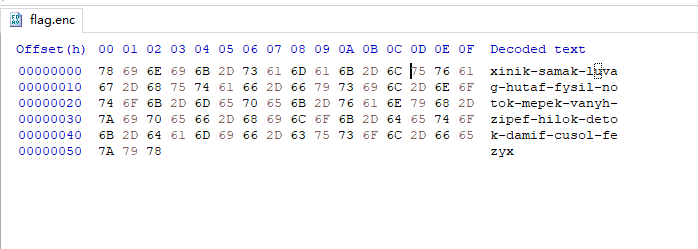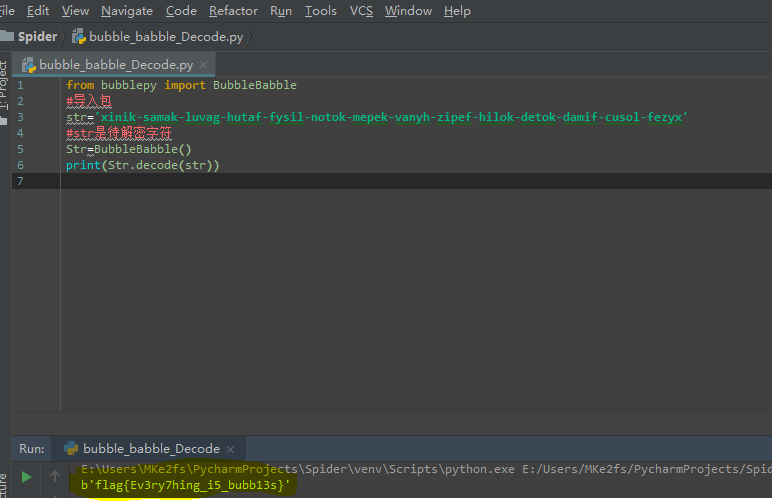这题很坑,刚开始我拿到就分析不出来了(/无奈),关键是不知道是什么加密算法,后来看题目描述的bubble,猜测是bubble
这种算法(听都没听说过。。。)
上图

这串编码
xinik-samak-luvag-hutaf-fysil-notok-mepek-vanyh-zipef-hilok-detok-damif-cusol-fezyx
百度也没找到哪里有,后面看到有大佬写的writeup,于是就借鉴一下下,233
这里是这种加密算法的解释(为了方便大家,加密算法我复制到文末),链接传送:http://wiki.yak.net/589/Bubble_Babble_Encoding.txt
附上解题代码,楼主用的python3.7,另外bubblepy这个库需要导入一下,网址附上https://pypi.python.org/pypi/bubblepy/
from bubblepy import BubbleBabble #导入包bubblepy str='xinik-samak-luvag-hutaf-fysil-notok-mepek-vanyh-zipef-hilok-detok-damif-cusol-fezyx' #str是待解密字符 Str=BubbleBabble() print(Str.decode(str))
最后,get Flag

这里是BubbleBabble加密算法
authors==Huima
status==Experimental
title==The Bubble Babble Binary Data Encoding
number==Internet Draft
date==April 2000
Network Working Group Antti Huima
Internet Draft SSH Communications Security
draft-huima-babble-01.txt April 2000
The Bubble Babble Binary Data Encoding
Status of this Memo
This memo provides information for the Internet community. It does
not specify an Internet standard of any kind. Distribution of this
memo is unlimited.
Copyright Notice
Copyright (C) The Internet Society (2000). All Rights Reserved.
Abstract
This document describes a new encoding method for binary data that is
intended to be used in conjunction with fingerprints of
security-critical data.
1. Introduction
Hash values of certificates and public keys, known as fingerprints
or thumbprints, are commonly used for verifying that a received
security-critical datum has been received correctly. Fingerprints
are binary data and typically encoded as series of hexadecimal
digits. However, long strings hexadecimal digits are difficult for
comprehend and cumbersome to translate reliably e.g. over phone.
The Bubble Babble Encoding encodes arbitrary binary data into
pseudowords that are more natural to humans and that can be
pronounced relatively easily. The encoding consumes asymptotically
the same amount of space as an encoding of the form
HH HH HH HH ...
where `H' is a hexadecimal digit, i.e. carries 16 bits in six
characters. However, the Bubble Babble Encoding includes a
checksumming method that can sometimes detect invalid encodings.
The method does not increase the length of the encoded data.
2. Encoding
Below, _|X|_ denotes the largest integer not greater than X.
Let the data to be encoded be D[1] ... D[K] where K is the length
of the data in bytes; every D[i] is an integer from 0 to 2^8 - 1.
First define the checksum series C[1] ... C[_|K/2|_] where
C[1] = 1
C[n] = (C[n - 1] * 5 + (D[n * 2 - 3] * 7 + D[n * 2 - 2])) mod 36
The data is then transformed into _|K/2|_ `tuples'
T[1] ... T[_|K/2|_] and one `partial tuple' P so that
T[i] = <a, b, c, d, e>
where
a = (((D[i * 2 - 3] >> 6) & 3) + C[i]) mod 6
b = (D[i * 2 - 3] >> 2) & 15
c = (((D[i * 2 - 3]) & 3) + _|C[i] / 6|_) mod 6
d = (D[i * 2 - 2] >> 4) & 15; and
e = (D[i * 2 - 3]) & 15.
The partial tuple P is
P = <a, b, c>
where if K is even then
a = (C[i]) mod 6
b = 16
c = _|C[i] / 6|_
but if it is odd then
a = (((D[K] >> 6) & 3) + C[i]) mod 6
b = (D[K] >> 2) & 15
c = (((D[K]) & 3) + _|C[i] / 6|_) mod 6
The `vowel table' V maps integers between 0 and 5 to vowels as
0 - a
1 - e
2 - i
3 - o
4 - u
5 - y
and the `consonant table' C maps integers between 0 and 16 to
consonants as
0 - b
1 - c
2 - d
3 - f
4 - g
5 - h
6 - k
7 - l
8 - m
9 - n
10 - p
11 - r
12 - s
13 - t
14 - v
15 - z
16 - x
The encoding E(T) of a tuple T = <a, b, c, d, e> is then the string
V[a] C[b] V[c] C[d] `-' C[e]
where there are five characters, and `-' is the literal hyphen.
The encoding E(P) of a partial tuple P = <a, b, c> is the
three-character string
V[a] C[b] V[c].
Finally, the encoding of the whole input data D is obtained as
`x' E(T[1]) E(T[2]) ... E(T[_|K/2|_]) E(P) `x'
where `x's are literal characters.
3. Decoding
Decoding is obviously the process of encoding reversed.
To check the checksums, when a tuple <a, b, c, d, e> or partial
tuple <a, b, c> has been recovered from the encoded string, an
implementation should check that ((a - C[i]) mod 6) < 4 and that
((c - C[i]) mod 6) < 4. Otherwise the encoded string is not a valid
encoding of any data and should be rejected.
4. Checksum Strength
Every vowel in an encoded string carries 0.58 bits redundancy; thus
the length of the `checksum' in the encoding of an input string
containing K bytes is 0.58 * K bits.
5. Test Vectors
ASCII Input Encoding
------------------------------------------------------------------
`' (empty string) `xexax'
`1234567890' `xesef-disof-gytuf-katof-movif-baxux'
`Pineapple' `xigak-nyryk-humil-bosek-sonax'
6. Author's Address
Antti Huima
SSH Communications Security, Ltd.
[XXX]
7. Full Copyright Statement
Copyright (C) The Internet Society (2000). All Rights Reserved.
This document and translations of it may be copied and furnished to
others, and derivative works that comment on or otherwise explain
it or assist in its implementation may be prepared, copied,
published and distributed, in whole or in part, without restriction
of any kind, provided that the above copyright notice and this
paragraph are included on all such copies and derivative works.
However, this document itself may not be modified in any way, such
as by removing the copyright notice or references to the Internet
Society or other Internet organizations, except as needed for the
purpose of developing Internet standards in which case the
procedures for copyrights defined in the Internet Standards process
must be followed, or as required to translate it into languages
other than English.
The limited permissions granted above are perpetual and will not be
revoked by the Internet Society or its successors or assigns.
This document and the information contained herein is provided on
an "AS IS" basis and THE INTERNET SOCIETY AND THE INTERNET
ENGINEERING TASK FORCE DISCLAIMS ALL WARRANTIES, EXPRESS OR
IMPLIED, INCLUDING BUT NOT LIMITED TO ANY WARRANTY THAT THE USE OF
THE INFORMATION HEREIN WILL NOT INFRINGE ANY RIGHTS OR ANY IMPLIED
WARRANTIES OF MERCHANTABILITY OR FITNESS FOR A PARTICULAR PURPOSE.